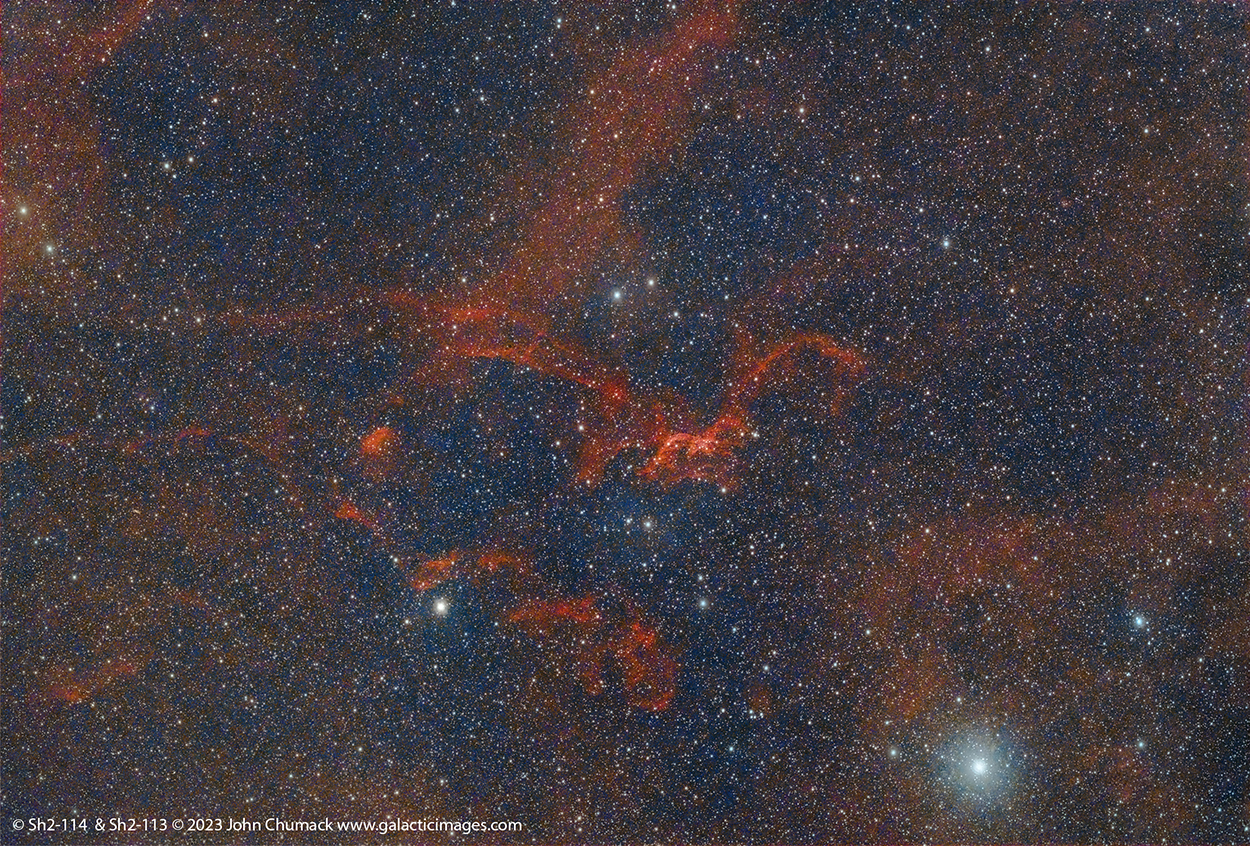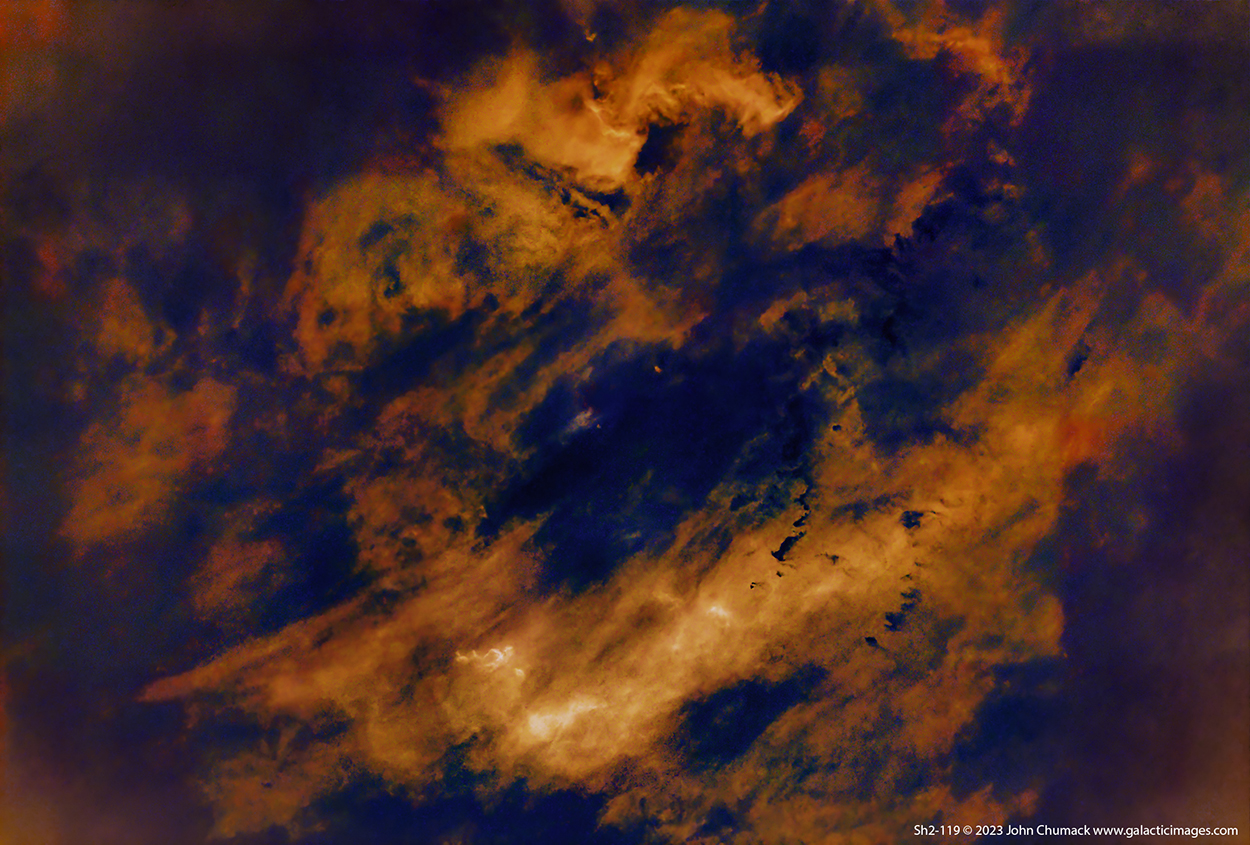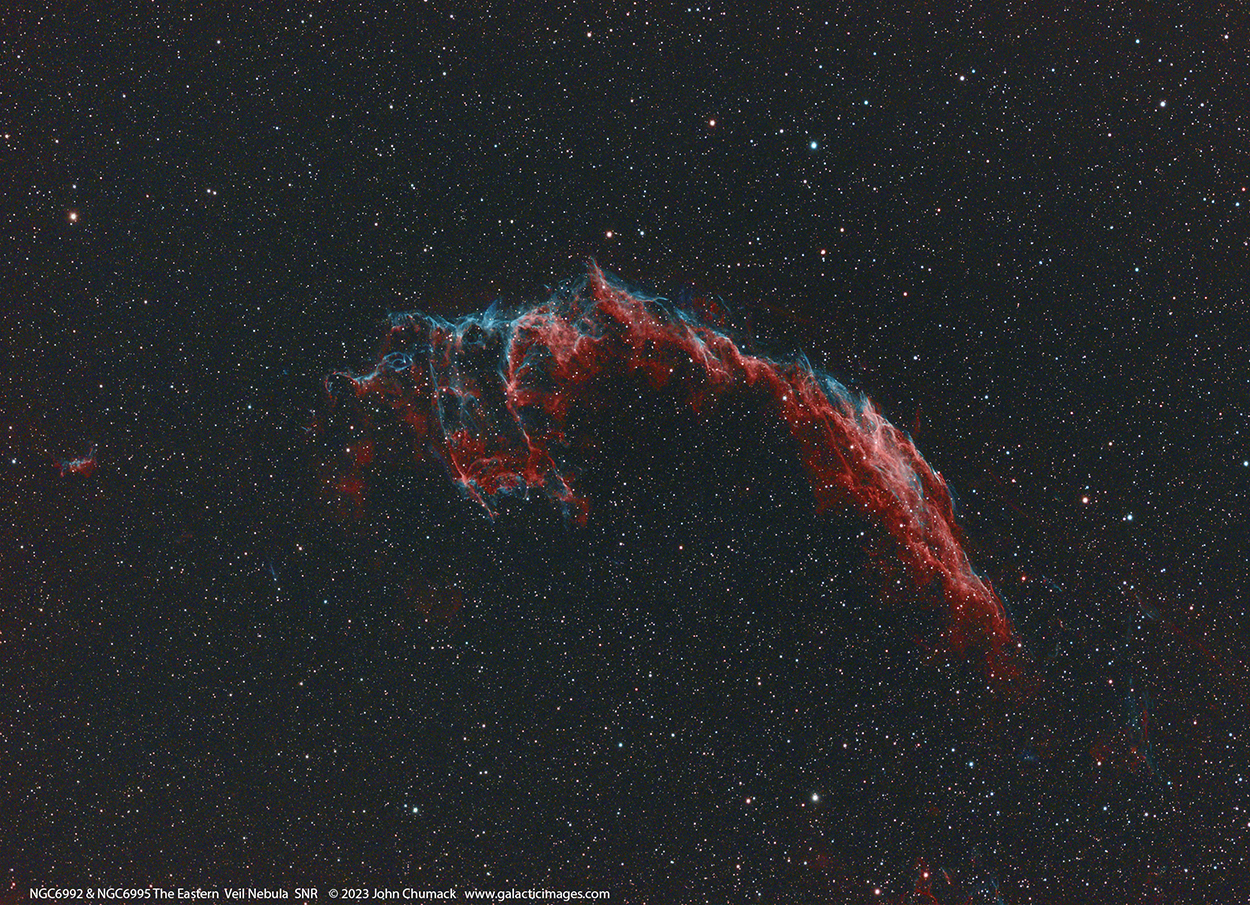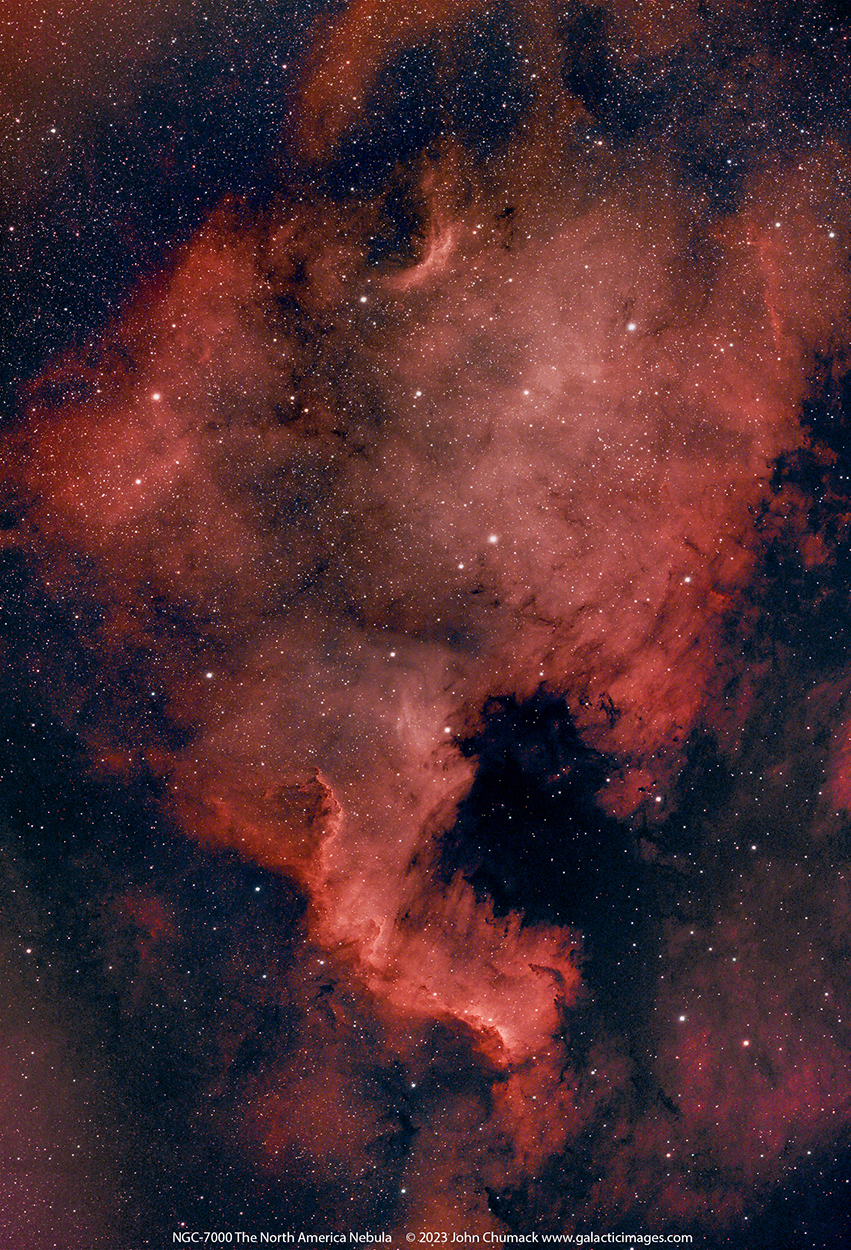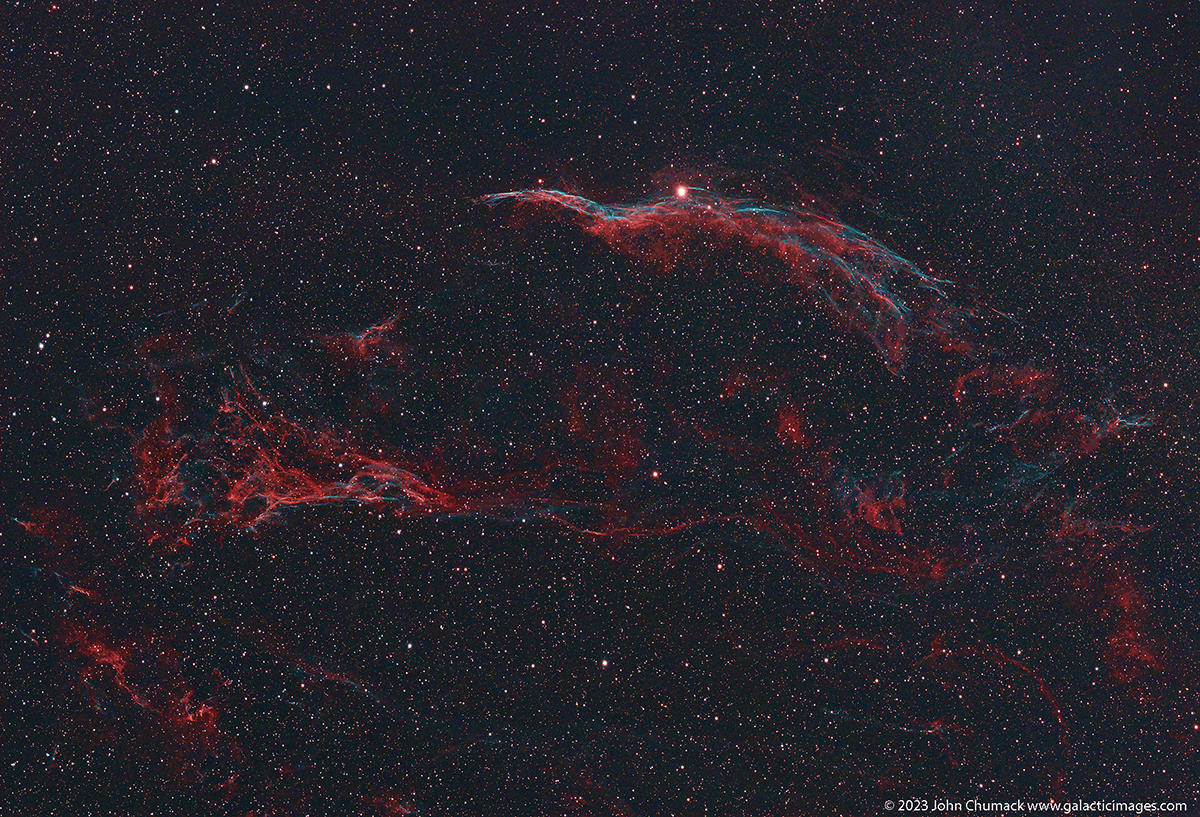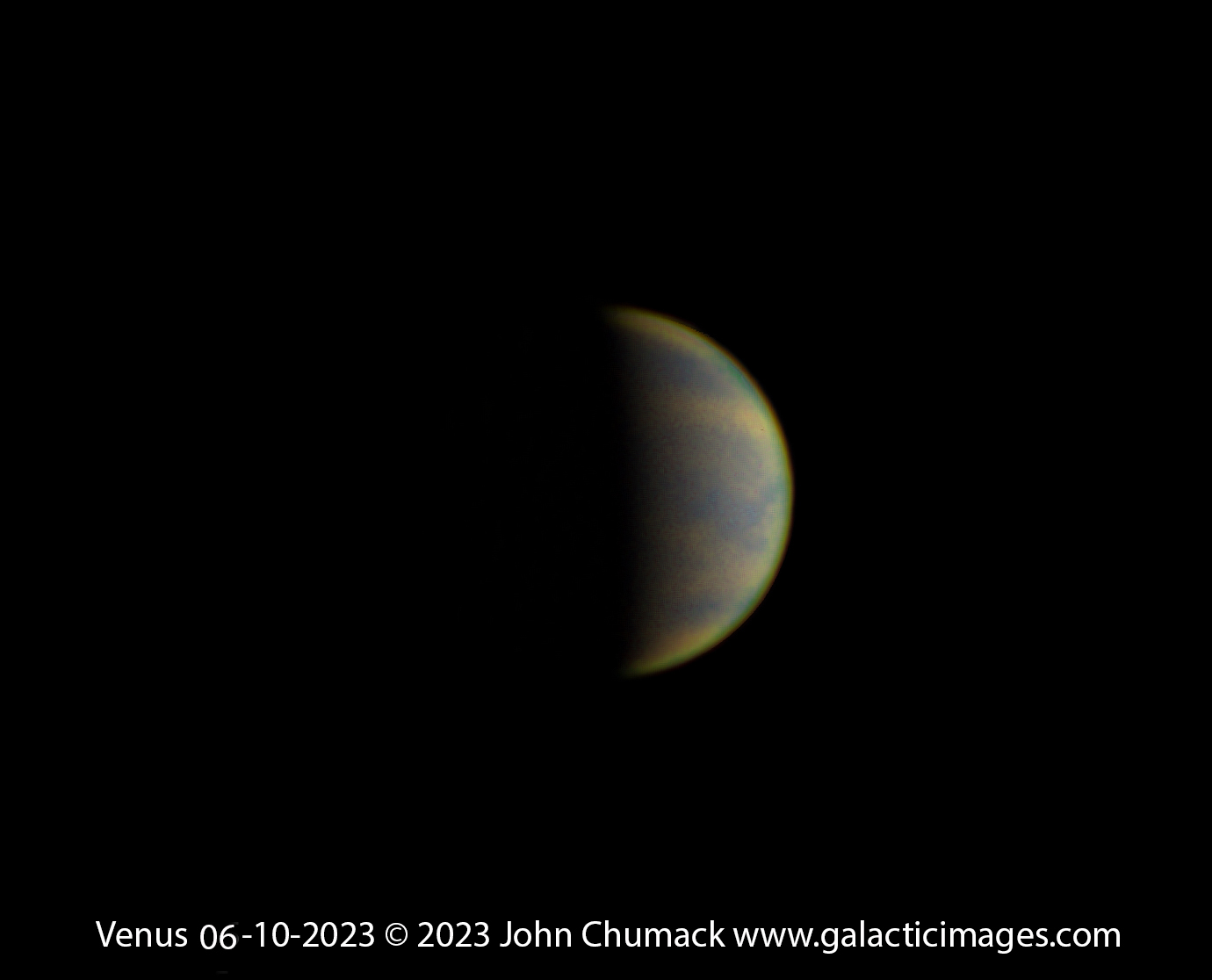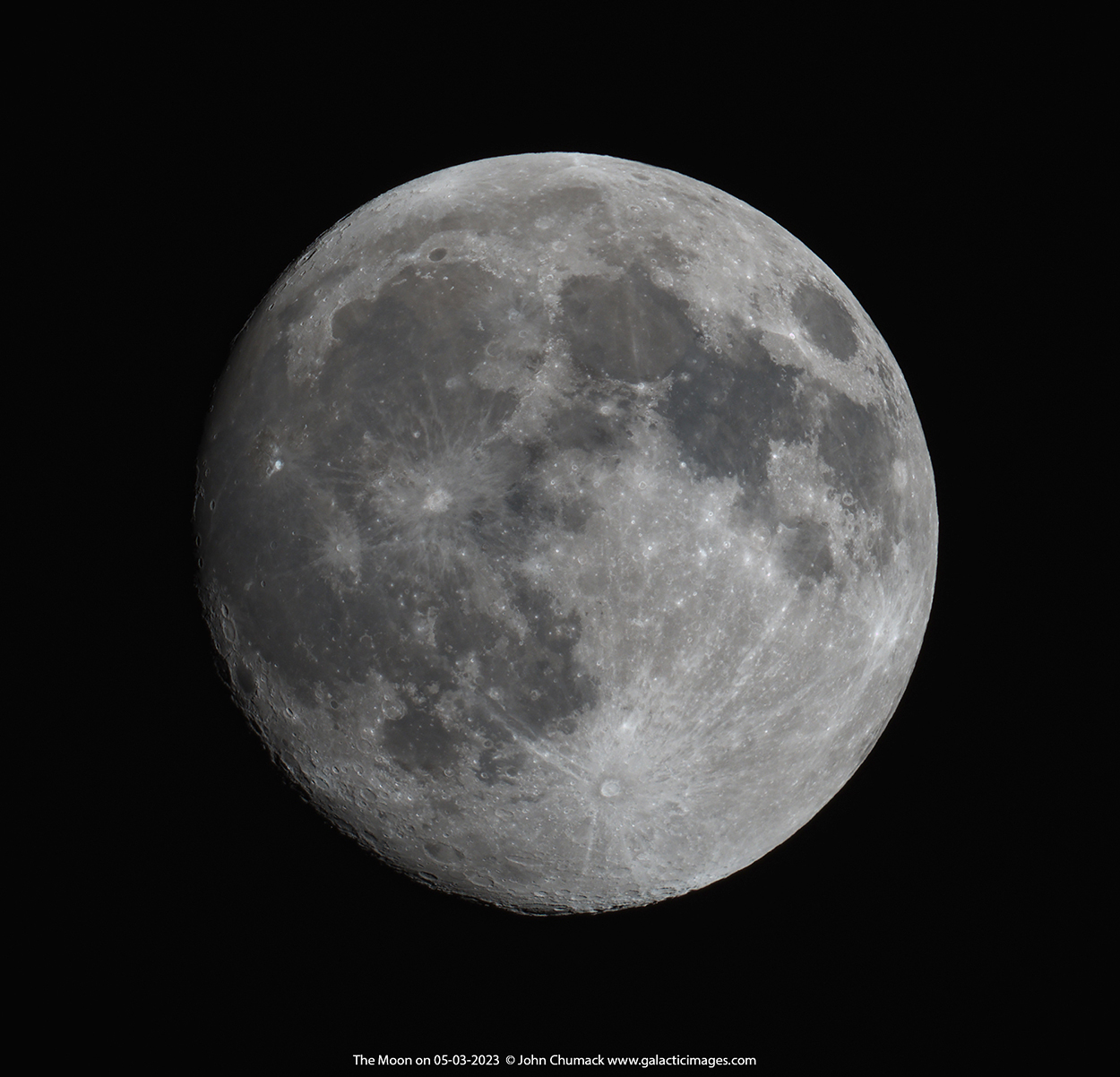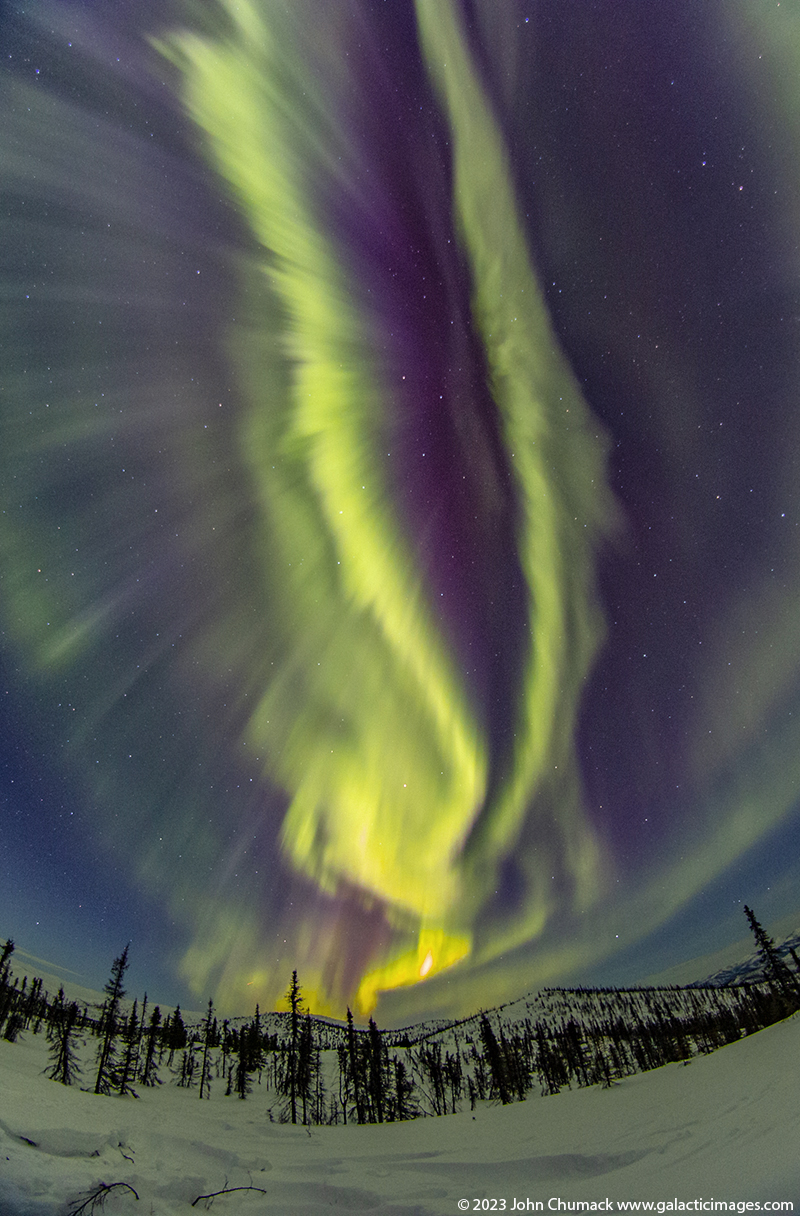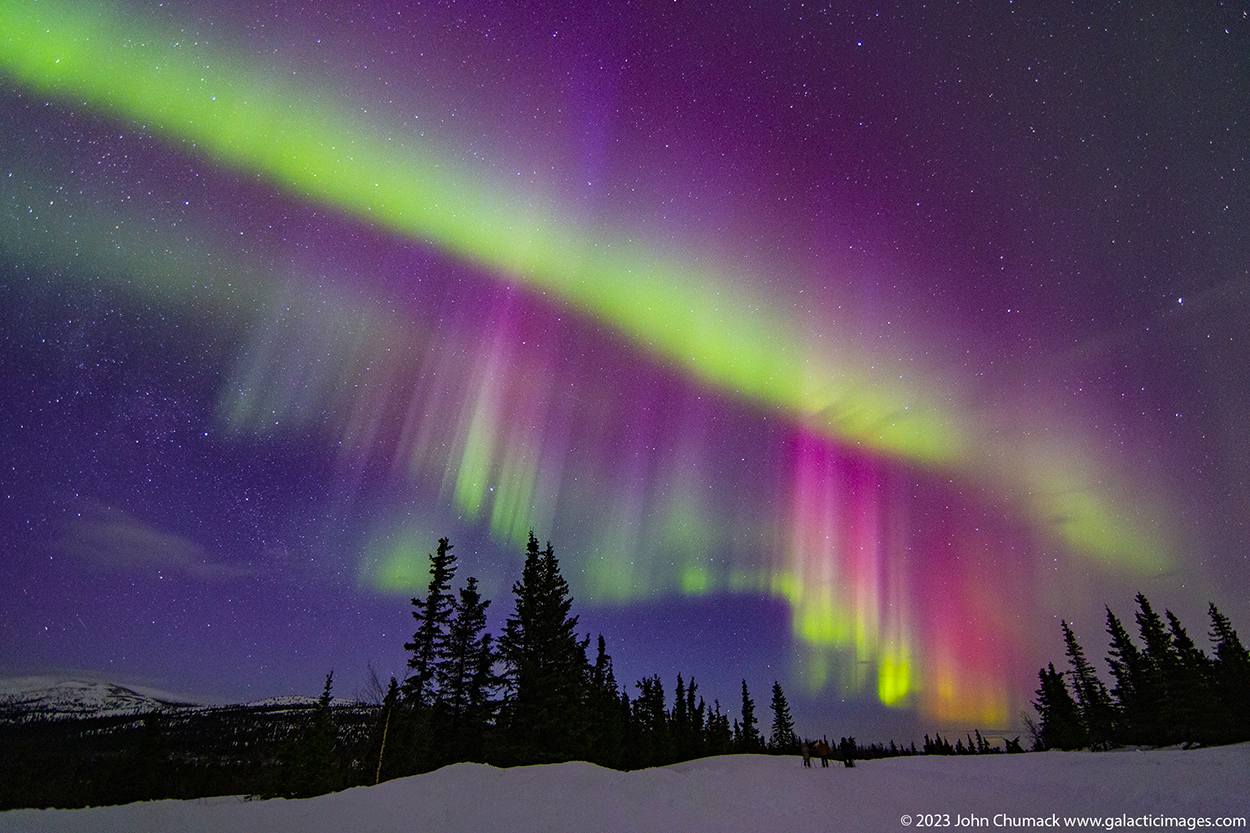Sh2-114 – The Flying Red Dragon Nebula in Cygnus
Sh2-114 The Flying Red Dragon Nebula in Cygnus, also known as LBN 347 and is embedded in the larger LBN 346 structure.
Some of the many objects in this FOV are Sh2-113, LBN 333, 67 Cygni, Planetary nebula PK 083-08.1, and several background PGC galaxies.
This was a really faint one,…no recorded magnitude could be found for this HII emission nebula.
This is a very faint but interesting Nebula hidden in this extremely rich star field located at 3,848 Light years from Earth in the Swan Constellation.
Some of the delicate structure looks similar to a (SNR) supernova remnant, but there are no recorded Supernova in this region.
Its complex, wispy structure is likely the result of winds from hot massive stars interacting with the magnetic fields in the interstellar medium.
But very little is known about it, So i decided to take a crack at it from my Backyard observatory(bortle8) in Dayton, Ohio on 07-29-2023.
Unfortunately, I had to toss out about half my image data due to thin cirrus clouds floating through my images last night,
but I still ended up with about 2 hours of usable data.
I did manage to stretch it enough to show a decent image.
Also a few faint galaxies are visible in the background as well.
RASA 8 inch F2.2 Telescope, Bisque MyT Mount, ZWO 294MC cooled Cmos Camera, Starizona NBZ UHS Filter, ASI Air Plus controlled via Wi-Fi to Ipad, 24 x 300sec subs, 2 hours total exp time.
Calibration & Processing via DSS, Pixinsight, and Adobe Raw CC 2023.
Best Regards,
John Chumack
www.galacticimages.com
The Pelican Nebula – wide angle with a RASA 8
Here is my shot taken while dodging fireworks & enduring the fire smoke /haze……
I see the vague Pelican head, but it looks more like a deer head profile facing right or pterodactyl head pointing left to me…what do you see???
The Pelican Nebula (also known as IC 5070 and IC 5067) is an H II star formation region associated with the North America Nebula in the constellation Cygnus.
Located about 1,800 light-years away, the Pelican is heavily studied because it has a particularly active mix of star formation and evolving gas clouds.
The light from young energetic stars is slowly transforming cold gas to hot and causing an ionization front gradually to advance outward.
Notice all the massive dark nebula present in this FOV?
I really like the large well defined mountains of gas and dust at the center.
Particularly dense filaments of cold gas are seen to still remain, and among these are two jets emitted from the Herbig–Haro object 555.
Capture details:
Celestron RASA 8″ F2.2 Scope, ZWO 294MC cooled Cmos Camera, Starizona NBZ UHS Filter, Bisque MyT Mount, ASI Air Plus via Wi-Fi,
24 x 300 sec. sub exposures, 120 min total integration time.
From my backyard Observatory in Dayton, Ohio(bortle8) on 07-03-2023
DSS, Pixinsight, and Adobe Raw 2023.
Best Regards,
John Chumack
www.galacticimages.com
Sh2-119 The Clamshell Nebula, A Close-up shot!
Sh2-119 The Clamshell Nebula Complex in Cygnus, occasionally a star field is so overwhelming that it makes it very difficult to see all the fine details within the Nebula.
Sometimes I use software to remove the stars, this helps me to explore, and discover new things that could easily be missed in a star studded FOV.
In the version with all the stars visible, the bright star at center is 68 A Cygni.
I have included a “Starless” version so that you too can explore the nebula’s finer dark dust and structural details.
Put them both up full screen and explore the Clamshell Nebula!
Sharpless 119 is a glowing cloud of gas and dust (star formation region) located about 2,200 light years from Earth.
Celestron RASA 8 inch F2.2 Scope, Bisque MyT Mount, ZWO 294MC cooled Cmos Camera, Starizona NBZ UHS filter, ASI Air Plus, 24 x 300 sec. sub exposures, 2 hour total integration time on 07-12-2023. Captured from my backyard Observatory(bortle8) in Dayton, Ohio. Calibration, Stacking, & Processing in DSS, Pixinsight, Adobe Raw CC 2023, StarXTerminator.
Best Regards,
John Chumack
www.galacticimages.com
NGC-6992 & NGC-6995 The Veil Nebula SNR (The Bat & Mosquito)
Here is my latest shot, now that the Canadian Fire/Smoke Haze has moved off to our East,
You should put this up full screen to see the finer details in the Supernova Remnant!!!
It’s a Supernova explosion from over 5,000 years ago,
The Veil Nebula is a cloud of heated and ionized gas and dust in the constellation Cygnus, located about 1, 470 light-years from Earth.
It constitutes the visible portions of the Cygnus Loop, a supernova remnant, many portions of which have acquired their own individual names and catalogue identifiers.
NGC-6992 & NGC-6995 The Eastern Veil Nebula SNR (Bat & Mosquito)
NGC6992 & NGC6995 The Eastern Veil Nebula in Cygnus, A beautiful Supernova Remnant
the left section known as the Bat, I had not previously noticed the small bright piece of the supernova remnant at the far left edge of this frame,
so I’m naming it the Mosquito, as it looks like the Bat is chasing it.
While I was dodging Fireworks and high clouds, and the nearly Full Moon that night, it finally cleared off long enough for me
to capture this image from my backyard observatory(bortle8) in Dayton, Ohio on 07-04-2023.
I was so happy to see that there was no fire smoke/haze over us for a change, lots of humidity and dew though.
My Capture details:
Celestron RASA 8 inch F2.2 Astrograph, Software Bisque MyT Robotic Mount, and ZWO 294MC Cooled Cmos Color Camera, ASI Air Plus via Wi-Fi to IPAD,
Starizona NBZ filter, 38 x 2 minute subs, 76 minute total exposure integration time. Calibration & Stacking in Deep Sky Stacker, Pixinsight, Adobe Raw CC 2023.
Best Regards,
John Chumack
www.galacticimages.com
NGC-7000 The North America Nebula Complex – RASA 8
Here is my latest close-up of the North America Nebula.
The North America Nebula Complex (NGC 7000 or Caldwell 20) is an emission nebula in the constellation Cygnus,
close to Deneb.
Distance: 2,590 ± 80 light years from Earth.
Celestron RASA 8 Inch F2.2 Scope, Bisque MyT Mount, ZWO 294MC cooled Cmos Camera, Starizona NBZ filter. DSS, Pixinsight, Adobe Raw CC 2023.
51 x 1 minute subs, total exposure integration time was 51 minutes,
from my backyard observatory in Dayton, Ohio(bortle8) on 06-18-2023.
Best Regards,
John Chumack
www.galacticimages.com
Veil Nebula SNR, Witches Broom, and Pickering’s Triangle with a RASA 8″
Looking through the Pea soup in Dayton Last night, I could only see about 9 stars visible, between light Pollution, fire smoke haze, and the poor transparency, I was pleasantly surprised to have gotten this nice image while testing my 8 inch scope out on the Veil Nebula Supernova Remnant Region. NGC6960 Veil Nebula, Witches Broom, and Pickering’s Triangle. 2,100 light years away from Earth.
Celestron RASA 8 inch diameter scope , ZWO 294MC cooled Cmos Camera, Starizona Filter drawer, IDAS NBZ Filter, 60 x 1 minute, no Auto-guiding, 60 min total, using Pro-track on Software Bisque MyT Robotic Mount. captured on 06-17-2023 from my (bortle8) backyard in Dayton, Ohio.
Best Regards,
John Chumack
www.galacticimages.com
The Planet Venus on 06-10-2023 UV & IR Light
My latest shot of Venus
I captured the Planet Venus in UV(ultra-violet 320-380nm) & IR(infrared 850nm) & Green wavelengths,
showing the clouds tops structure of Sulfuric Acid Clouds in the Venusian atmosphere.
Venus is the second planet from the Sun and Earth’s closest planetary neighbor.
It’s distance is currently ~ 61 Million miles from Earth,
or 98,955,797 kilometers, equivalent to 0.661479 Astronomical Units.
Even though Mercury is closer to the Sun,
Venus is the hottest planet in our solar system. Its thick atmosphere is full of the greenhouse gas carbon dioxide, and it has clouds of sulfuric acid.
The Surface temperatures on Venus are about 900 degrees Fahrenheit (475 degrees Celsius) – hot enough to melt lead. The surface is a rusty color and it’s peppered with intensely crunched mountains and thousands of large volcanoes.
Captured on 06-10-2023 @ 01:38 UT from Dayton, Ohio. I was imaging at dusk, sky still blue, but needed to capture it before my neighbors trees covered it up. C-11 SCT telescope, F20 via a 2x Barlow, (5600mm), Software Bisque MyT Mount, QHY 290M uncooled Cmos Camera, ZWO 5 position filter wheel, Baader IR RGB UV filters, Fire_Capture Software, saved as SER video File, Stacked in Autostakkert, Wavelets in Regitaxs6, combined UV, IR & Green channels in Maxim DL., final in Adobe Raw CC 2023.
I captured 2000 frames for each channel in IR, UV, and standard RGB files, I then processed them all,
choosing the best filter channel combinations that best displayed the most cloud tops details visible during my imaging session.
Best Regards,
John Chumack
www.galacticimages.com
Waxing Gibbous Moon on 05-03-2023
Here is a shot of the Waxing Gibbous Moon from last night….95% lit, as it heads for Full Moon on Friday.
Waxing Gibbous Lunar Phase:
This phase occurs between the first quarter and full Moon and describes the Moon when it is more than half lit, but not yet fully. At the beginning of this stage in the Northern Hemisphere, we see the right half of the Moon illuminated plus a tiny fraction more extending into the left side. As the days pass, the light creeps farther left, covering more and more of the Moon’s surface until the full Moon phase, when the entire disk is illuminated. In the Southern Hemisphere, the same happens, only from left to right.
“Gibbous” comes from a Latin word meaning “humpbacked,” referring to the curved lit area on the Moon’s surface.
The average composition of the lunar surface by weight is roughly 43% oxygen, 20% silicon, 19% magnesium, 10% iron, 3% calcium, 3% aluminum, 0.42% chromium, 0.18% titanium and 0.12% manganese. Orbiting spacecraft have found traces of water on the lunar surface that may have originated from deep underground or just below the surface inside shadowed craters.
Some rare elements have also been detected, the Moon may also have ores of rare elements such as beryllium, lithium, zirconium, niobium, tantalum, and so forth.
I captured this shot from my backyard observatory in Dayton, Ohio on 05-03-2023, using my 6 inch diameter F5 Newtonian reflector telescope, on a Bisque MyT Robotic Tracking Mount, and a ZWO 294MC Cooled Color Cmos Camera, for a single 3ms exposure.
On Friday the Moon will be Full once again.
You can look for the Full “Flower Moon” on Friday evening May 5th 2023,
The Flower Moon is named after the abundant flowers that grow in the Earth’s Northern Hemisphere in May.
Best Regards,
John Chumack
www.galacticimages.com
Fantastic Coronal Aurora – Venus Fly Trap Aurora
I know we just had another KP-8 Aurora seen over the USA and Ohio recently, unfortunately it was cloudy all night for us here in Dayton, Ohio.
So I’m sharing this image that I captured last Month in Alaska.
Here is an amazing Coronal Aurora display that I captured with a Fish-eye lens and cropped slightly to create a vertical view.
It reminds me of a carnivores plant like a giant Venus Fly Trap,
Looks like a big mouth that is ready to eat anything on the Earth.
It was centered on the bowl of the Big Dipper,
I love how the magnetic field lines can create incredible art and watching this Coronal Aurora was spectacular!
Canon 6D DSLR, 8mm Fish-eye Lens, F3.5, ISO 3200, 10 second exposure.
On 03-25-2023, The Chena River State Recreational Area in Alaska.
Yes, I’m back in the lower 48, and I’m looking forward to imaging deep space once again.
Best Regards,
John Chumack
www.galacticimages.com
A Stunning and Colorful Aurora Curtain on 03-23-2023
I’m still going through all my Aurora shot taken this past March,
and this has to be my most breathtakingly beautiful one captured so far.
The Aurora display was absolutely stunning!
A wide colorful Curtain of Aurora taken on 03-23-2023 north of Fairbanks, Alaska.
As the wide colorful curtain lowers between two higher altitude Green/Red Aurora Walls.
You can see some thin clouds floating through, as well as some of my crew shooting further down the road.
Canon 6D DSLR Camera, 16mm F2.8lens, ISO 3200, 8 second exposure.
Its a keeper for sure!
I’m definitely printing this one on Metal to 30″ x 45″.
Best Regards,
John Chumack
www.galacticimages.com


